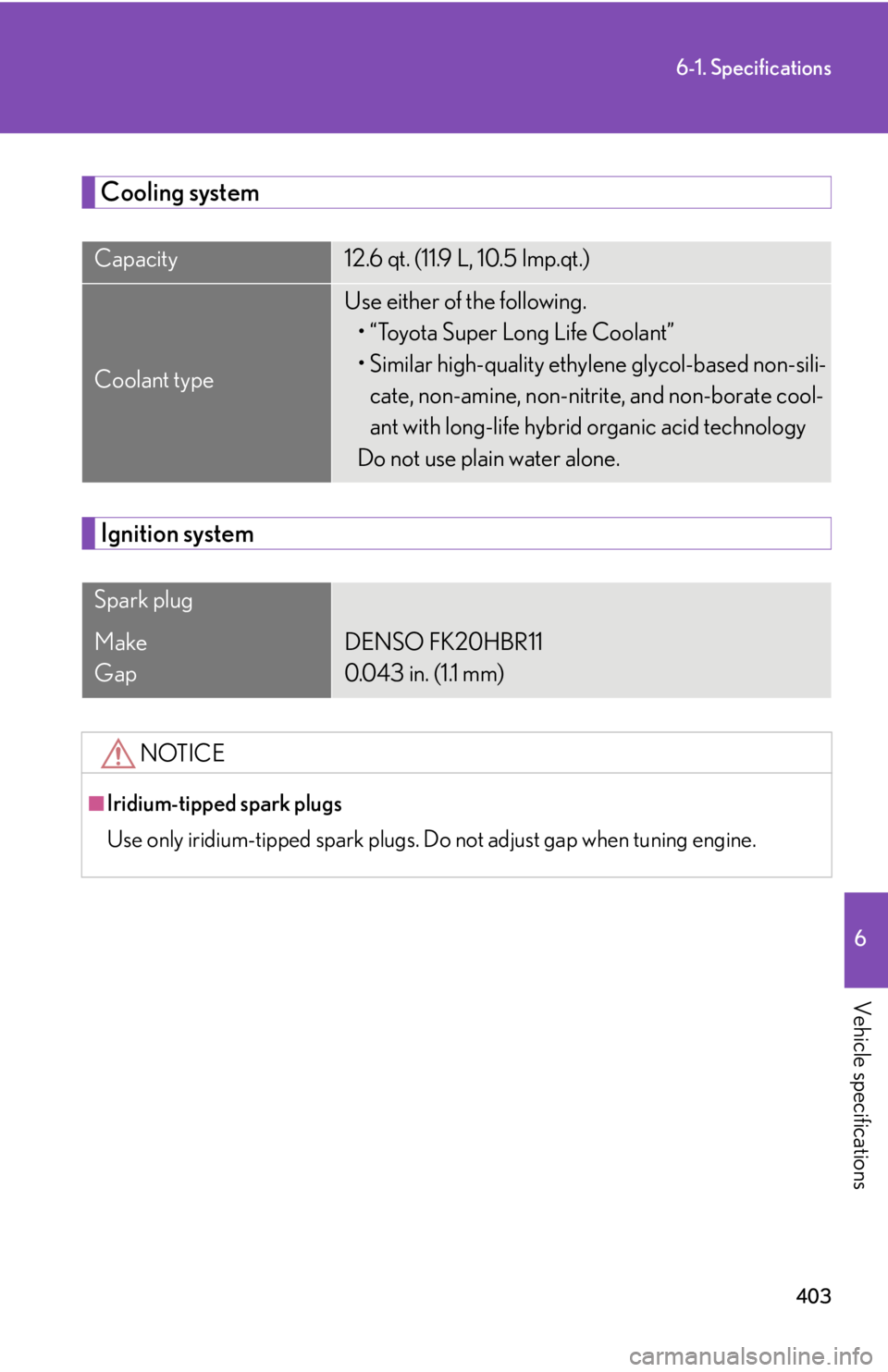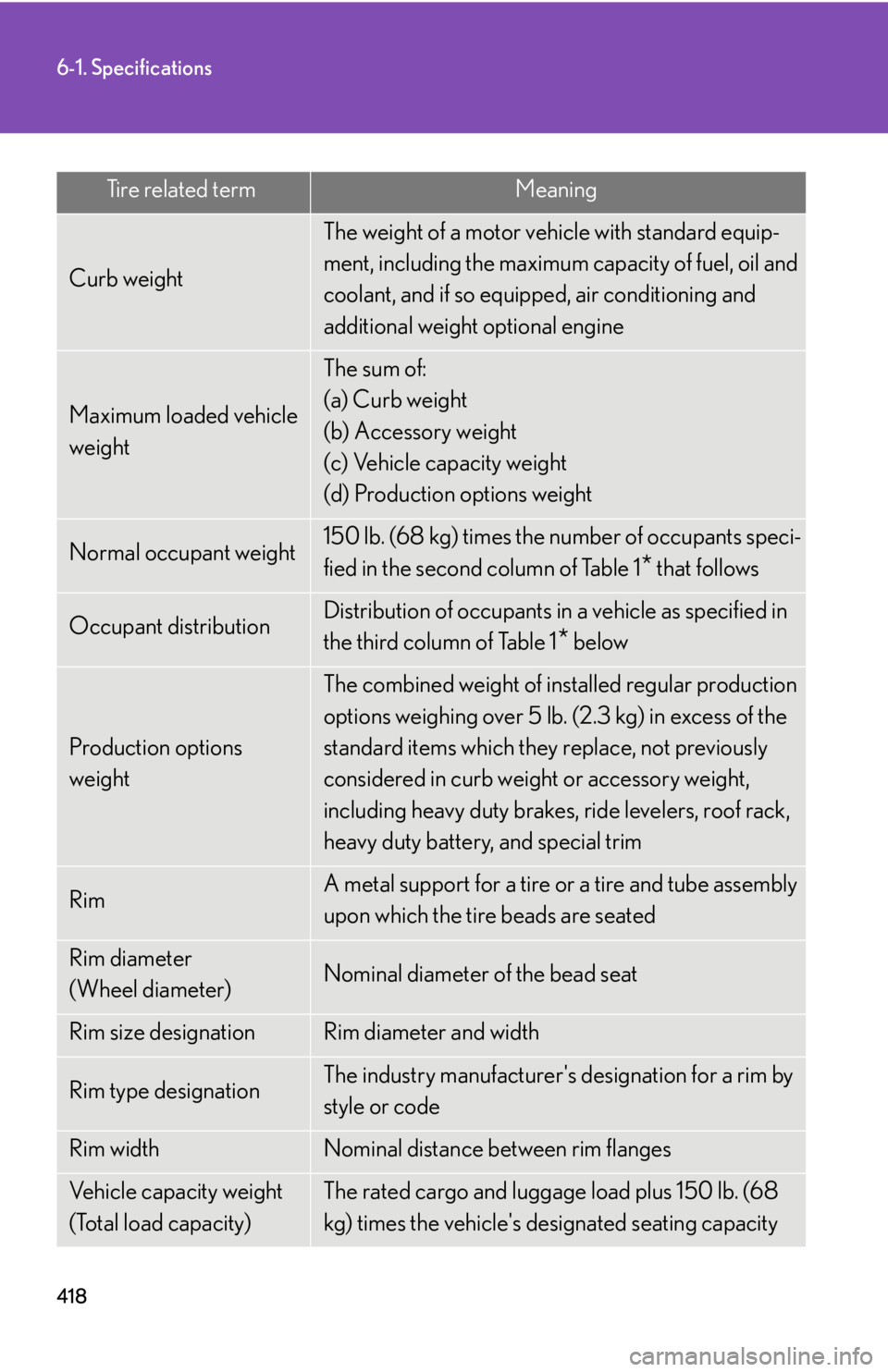engine coolant Lexus IS F 2008 Do-It-Yourself Maintenance /
[x] Cancel search | Manufacturer: LEXUS, Model Year: 2008, Model line: IS F, Model: Lexus IS F 2008Pages: 452, PDF Size: 6.49 MB
Page 346 of 452

346
5-1. Essential information
If you think something is wrong
If you notice any of the following symptoms, your vehicle probably needs
adjustment or repair. Contact your Lexus dealer as soon as possible.
■Visible symptoms
●Fluid leaks under the vehicle
(Water dripping from the air conditioning after use is normal.)
● Flat-looking tires or uneven tire wear
● Engine coolant temper ature gauge needle continually points
higher than normal
■ Audible symptoms
●Changes in exhaust sound
● Excessive tire squeal when cornering
● Strange noises related to the suspension system
● Pinging or other noises related to the engine
■ Operational symptoms
●Engine missing, stumbling or running rough
● Appreciable loss of power
● Vehicle pulls heavily to one side when braking
● Vehicle pulls heavily to one side when driving on a level road
● Loss of brake effectiveness, sp ongy feeling, pedal almost touches
the floor
Page 392 of 452

392
5-2. Steps to take in an emergency
If your vehicle overheats
If your engine overheats:
Stop the vehicle in a safe place and turn off the automatic air
conditioning system.
Check to see if steam is coming out from under the hood.
If you see steam: Stop the engine. Carefully lift the hood after the steam sub-
sides and then restart the engine.
If you do not see steam: Leave the engine running and carefully lift the hood.
Remove the engine compartment cover. ( P. 283)
Check to see if the cooling fan is operating.
If the fan is operating: Wait until the temperature of the engine (shown on the
instrument cluster) begins to fall and then stop the engine.
If the fan is not operating: Stop the engine immediately and call your local Lexus
dealer.
After the engine has cooled
down sufficiently, check the
engine coolant level and inspect
the radiator core (radiator) for
any leaks.STEP1
STEP2
STEP3
STEP4
STEP5
Page 393 of 452

5
When trouble arises
393
5-2. Steps to take in an emergency
■Overheating
If you observe the following, your vehicle may be overheating.
●The engine coolant temperature gauge enters the red zone or a loss of power is
experienced.
●Steam is coming from under the hood.
CAUTION
■To prevent an accident or injury when in specting under the hood of your vehicle
●If steam is seen coming from under the hood, do not open the hood until the
steam has subsided. The engine compartm ent may be very hot, causing serious
injury such as burns.
●Keep hands and clothing away from the fa n and belt while the engine is running.
●Do not loosen the coolant reservoir cap while the engine and radiator are hot.
Serious injury, such as burns, may resu lt from hot coolant and steam released
under pressure.
Add engine coolant if neces-
sary.
Water can be used in an emer-
gency measure if engine coolant
is unavailable. ( P. 4 0 3 )
Have the vehicle checked at your nearest Lexus dealer as soon as pos-
sible.
STEP6
Page 394 of 452

394
5-2. Steps to take in an emergency
NOTICE
■When adding engine coolant
Wait until the engine has cooled down before adding engine coolant.
When adding coolant, do so slowly. Adding cool coolant to a hot engine too quickly
can cause damage to the engine.
Page 403 of 452

403
6-1. Specifications
6
Vehicle specifications
Cooling system
Ignition system
Capacity12.6 qt. (11.9 L, 10.5 lmp.qt.)
Coolant type
Use either of the following.• “Toyota Super Long Life Coolant”
• Similar high-quality ethylene glycol-based non-sili- cate, non-amine, non-nitrite, and non-borate cool-
ant with long-life hybrid organic acid technology
Do not use plain water alone.
Spark plug
Make
GapDENSO FK20HBR11
0.043 in. (1.1 mm)
NOTICE
■Iridium-tipped spark plugs
Use only iridium-tipped spark plugs. Do not adjust gap when tuning engine.
Page 418 of 452

418
6-1. Specifications
Curb weight
The weight of a motor vehicle with standard equip-
ment, including the maximum capacity of fuel, oil and
coolant, and if so equipped, air conditioning and
additional weight optional engine
Maximum loaded vehicle
weight
The sum of:
(a) Curb weight
(b) Accessory weight
(c) Vehicle capacity weight
(d) Production options weight
Normal occupant weight150 lb. (68 kg) times the number of occupants speci-
fied in the second column of Table 1
* that follows
Occupant distributionDistribution of occupants in a vehicle as specified in
the third column of Table 1
* below
Production options
weight
The combined weight of installed regular production
options weighing over 5 lb. (2.3 kg) in excess of the
standard items which they replace, not previously
considered in curb weight or accessory weight,
including heavy duty brakes, ride levelers, roof rack,
heavy duty battery, and special trim
RimA metal support for a tire or a tire and tube assembly
upon which the tire beads are seated
Rim diameter
(Wheel diameter)Nominal diameter of the bead seat
Rim size designationRim diameter and width
Rim type designationThe industry manufacturer's designation for a rim by
style or code
Rim widthNominal distance between rim flanges
Vehicle capacity weight
(Total load capacity)The rated cargo and luggage load plus 150 lb. (68
kg) times the vehicle's designated seating capacity
Tire related termMeaning
Page 441 of 452

441
Alphabetical index
Electric power steering ....................... 166
Electronic keyIf the electronic key does not operate properly ............................ 386
Emergency, in case of If the engine will not start ............... 383
If the shift lever cannot be shifted from P ................................... 384
If the vehicle has discharged battery.................................................. 389
If the warning buzzer sounds......350
If the warning light turns on ..........350
If the warning message is displayed ............................................ 360
If you have a flat tire .........................374
If you lose your keys ........................385
If you think something is wrong................................................... 346
If the electronic key does not operate properly ............................ 386
If your vehicle becomes stuck .... 395
If your vehicle needs to be towed ................................................... 340
If your vehicle overheats................ 392 Engine
ACCESSORY mode......................... 114
Compartment......................................282
Engine switch .......................................... 114
Hood ........................................................ 279
How to start the engine ..................... 114
Identification number ...................... 399
If the engine will not start............... 383
Ignition switch ......................................... 114
Overheating .........................................392
Engine compartment cover .............283
Engine coolant Capacity ................................................ 403
Checking .............................................. 288
Preparing and checking before winter .....................................180
Engine coolant temperature gauge....................................................... 128
Engine immobilizer system.................. 70
Engine oil Capacity .................................................402
Checking ...............................................284
Preparing and checking before winter .....................................180
Engine oil maintenance data............286
EPS .............................................................. 166
Event data recorder ............................348E
Page 449 of 452

449
What to do if...
What to do if...
A tire puncturesP. 3 74If you have a flat tire
The engine does not start
P. 3 8 3If the engine will not start
P. 7 0Engine immobilizer system
P. 3 8 9If the vehicle battery is discharged
The shift lever cannot be
moved outP. 3 8 4If the shift lever cannot be shifted
from P
The engine coolant temperature
gauge enters the red zone
Steam can be seen coming
from under the hood
P. 3 9 2If your vehicle overheats
The key is lostP. 3 8 5If you lose your keys
The battery runs outP. 3 8 9If the vehicle battery is discharged
The doors cannot be lockedP. 3 7Doors
The horn begins to soundP. 7 2Alarm
The vehicle is stuck in mud or
sandP. 3 9 5If the vehicle becomes stuck